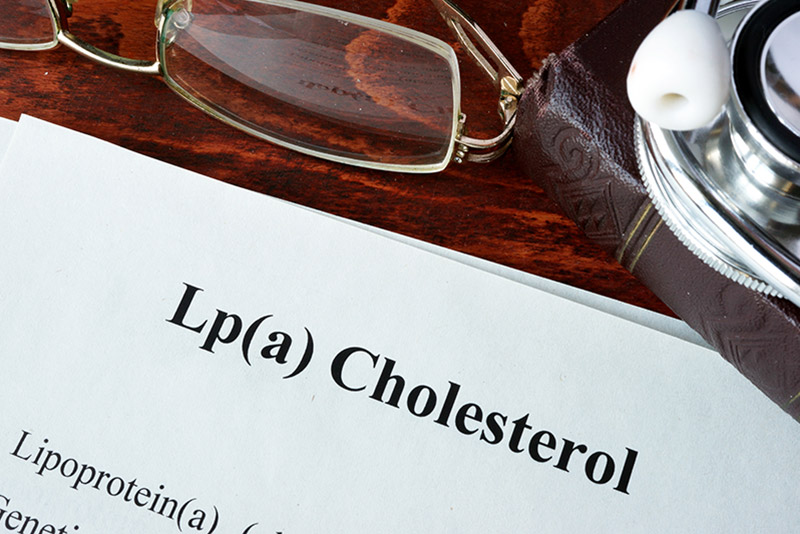- Home
- About Us
- Advanced Testing
- Nutrition & Self-Care
- Further Learning
- New Member Info
- Contact
Lipoprotein(a) is an inherited type of LDL cholesterol that accelerates the progression of atherosclerosis (plaque build up in the arteries). Also known as “sticky cholesterol,” it is a small, dense, highly inflammatory protein that has been shown to be an independent risk factor for early coronary artery disease (as acknowledged by the American Heart Association, American College of Cardiology, and European Atherosclerosis Society). 1 2 3 Think of Lp(a) like a “FAST PASS” – it gets cholesterol into the lining of the artery quicker. In addition, elevated Lp(a) levels can also increase a patient’s propensity for developing blood clots. 4

One in five people have high Lp(a) levels, and most of these people do not know they are at risk.
The amount of Lp(a) your body makes is determined by genetics (you have to inherit the ability to produce it from one of your parents).
18% of patients with premature coronary artery disease (CAD) have elevated Lp(a). High Lp(a) is the strongest, single, inherited risk factor for early blockages in the heart and aortic stenosis (narrowing of the aortic valve opening in the heart). 12
According to the Copenhagen data, as Lp(a) levels went up there was a consistent increase in the risk of a heart attack, starting at a level around 40-50 mg/dL. Each doubling of the level increased the CV risk an additional 20%. 6
Lp(a) can raise the risk of cardiovascular disease by 200–400%. High levels of Lp(a) have been correlated with an increased risk of: coronary artery disease (CAD), stroke, peripheral vascular disease (PVD), abdominal aortic aneurysm (AAA), re-stenosis (after a stent), and retinal artery occlusion (obstruction of blood flow in the eyes).
At WHFM, we believe everyone should find out as soon as possible if they carry this silent artery clogger. However, certain groups of people should absolutely ask for the test. These include:
People who have personally suffered a heart attack or stroke (especially without any other known risk factors).
People who have a family member with early heart disease or stroke (men younger than 55 years of age and women less than 65 years of age)
People who have family members (parents, siblings, children) with high Lp(a). If a parent has high Lp(a), the child has a 50% chance of inheriting it.
People taking cholesterol medication who still have abnormal lipids. (It could be the LDL cholesterol in Lp(a) that is contributing to these elevations).
The European Atherosclerosis Society (EAS) recommends screening everyone for Lp(a) and treating with niacin if levels are over 50 mg/dL. 9 15 Unfortunately, in the U.S. the test for Lp(a) is not included in most standard cholesterol panels.
A simple blood test can measure your Lp(a) level, and because lipoprotein (a) is an inherited condition, levels only have to be checked once if they are normal.
Approximately 20–30% of people have high levels of Lp(a). That means over 60 million people in the USA alone have elevated levels. Elevated levels are more common in African-Americans and those of Asian descent.
Bob Harper, the celebrity trainer and host from the show The Biggest Loser, had a near-fatal heart attack at age 51. He later found out he had elevated Lp(a), which is a strong contributing factor to premature coronary artery disease. 5 Harper has since made many lifestyle changes, written a book, and become an advocate for Lp(a) testing. You can read his story HERE.
Levels of Lp(a) are reported in different units, either mg/dL or nmols/L. A normal level is less than 30 mg/dL or less than 75 nmols/L.

Approximately 20–30% of people have high levels of Lp(a). That means over 60 million people in the USA alone have elevated levels. Elevated levels are more common in African-Americans and those of Asian descent.
Bob Harper, the celebrity trainer and host from the show The Biggest Loser, had a near-fatal heart attack at age 51. He later found out he had elevated Lp(a), which is a strong contributing factor to premature coronary artery disease. 5 Harper has since made many lifestyle changes, written a book, and become an advocate for Lp(a) testing. You can read his story HERE. put link below over HERE.

Levels of Lp(a) are reported in different units, either mg/dL or nmols/L. A normal level is less than 30 mg/dL or less than 75 nmols/L.
Lowering Lp(a) has been shown to reduce CV risk by 70-75% but there is no prescription treatment available at this time that is indicated for lowering Lp(a). We are limited in effective therapies. 10 Because of this, patients with elevated Lp(a) should be treated aggressively for all other CV risk factors (blood pressure, blood sugar, sleep apnea, poor diet, smoking, lack of exercise, etc.). Doing this can lower the patient’s risk of a heart attack or stroke even if they have high Lp(a).
Unfortunately, diet and exercise have no impact on lowering Lp(a) levels, and neither do statin cholesterol medications. A meta-analysis of over 29,000 patients showed that statin treatment does not mitigate the risk of Lp(a). 8
The most effective treatment we have now for lowering Lp(a) is high dose niacin (nicotinic acid), a form of vitamin B3. This vitamin can lower levels by about 25% (while also lowering LDL cholesterol, lowering triglycerides, improving particle size, and raising HDL cholesterol). The EAS advises 1-3g of niacin daily, but it can cause a side effect of flushing. 9 Other than this irritating side effect, niacin has been used safely for decades.
In addition to niacin, we know estrogen can lower Lp(a) levels. 13 Lp(a) levels do not change much during one’s lifetime unless you are a woman. During menopause Lp(a) levels go up as estrogen level decline. In post-menopausal women, a recent review demonstrated a powerful effect of hormone replacement therapy on Lp(a) levels. 14 Data from the HERS trial confirms this. In this trial, 2,763 postmenopausal women with a history of heart disease were put on Prempro. Overall this trial showed that hormone replacement therapy (HRT) conferred no CV benefit, but in the subset of patients who had elevated Lp(a), HRT DID show a reduction in CV events! Take home message - HRT may be worth considering for women with high Lp(a).
L-carnitine is an amino acid that can lower Lp(a) and even improve outcomes after heart attacks. However, L-Carnitine can sometimes raise TMAO levels (a type of gut bacteria that can increase CV risk). We do not recommend patients supplement with L-Carinitine unless they are getting their TMAO levels checked.
The newer injectable drugs (PCSK9 inhibitors), used in high risk CV patients to lower cholesterol, can also lower Lp(a) about 25 – 30%. However, these medications are extremely expensive and at this time are not indicated for lowering Lp(a). 13
Apheresis (like hemodialysis) is a very effective treatment for lowering Lp(a). It cleanses the blood of Lp(a) through a filter. Apheresis is available and approved for use but it is an invasive and time intensive therapy, so only high risk patients with severe Lp(a) abnormalities are typically referred for this therapy.
There are promising new treatments for lowering Lp(a) that are currently undergoing clinical trials, but it will be several years before the results are available.
In the end, you can be thin, exercise, and eat a lot of salmon and kale and still have high levels of Lp(a), but you do not have to wonder if you are at risk . . . you can get tested to find out.
*Learn more about Lp(a) at the Lipoprotein(a) Foundation.
Do something today for a better tomorrow!
Make an appointment now for advanced testing. We are here to help.
REFERENCES
1 – Nordestgaard BG, Chapman MJ, Ray K, et al. Lipoprotein(a) as a cardiovascular risk factor: current status. Eur Heart J. 2010;31(23):2844–2853.
2 – Hoff HF, Beck GJ, Skibinski CI, et al. Serum Lp(a) level as a predictor of vein graft stenosis after coronary artery bypass surgery in patients. Circulation. 1988;77(6):1238–1244.
3 - Lamon-Fava S, Marcovina SM, Albers JJ, Kennedy H, Deluca C, White CC, Cupples LA, McNamara JR, Seman LJ, Bongard V, Schaefer EJ. Lipoprotein(a) levels, isoforms, and coronary heart disease risk in the Framingham Off spring Study. J Lipid Res. 2011;52(6):1181-1187.
4 – Okafor, O. N., & Gorog, D. A. (2015). Endogenous Fibrinolysis An Important Mediator of Thrombus Formation and Cardiovascular Risk. J Am Coll Cardiol, 65(16), 1683-1699.
5 – https://www.aarp.org/health/healthy-living/info-2018/bob-harper-heart-attack-fd.html
6 – Kamstrup, P. R., et. al. (2009). Genetically elevated lipoprotein(a) and increased risk of myocardial infarction. JAMA, 301(22), 2331-2339.
7 - Virani, S. S., et. al. (2012). Associations Between Lipoprotein(a) Levels and Cardiovascular Outcomes in Black and White Subjects: The Atherosclerosis Risk in Communities (ARIC) Study. Circulation, 125(2), 241-249.
8 - https://www.aarp.org/health/healthy-living/info-2018/bob-harper-heart-attack-fd.html
9 – Nordestgaard, B. G., et. al. (2010). Lipoprotein(a) as a cardiovascular risk factor: a current status. Eur Heart J. doi: 10.1093/eurheartj/ehq386
10 - Leebman, J., et. al. (2013). Lipoprotein Apheresis in Patients With Maximally Tolerated Lipid-Lowering Therapy, Lipoprotein(a)-Hyperproteinemia, and Progressive Cardiovascular Disease. Prospective Observational Multicenter Study. Circulation. 128(24), 2567-2576.
11 - Qin et al Atherosclerosis 2013;227:360-366
12 - https://www.lipoproteinafoundation.org/page/UnderstandLpa
13 - https://www.ahajournals.org/doi/10.1161/CIRCULATIONAHA.118.037184
14 – https://www.ncbi.nlm.nih.gov/pubmed/28364865
15 – https://www.eas-society.org/page/lp_a_consensus
16 – https://www.ncbi.nlm.nih.gov/pubmed/17845920